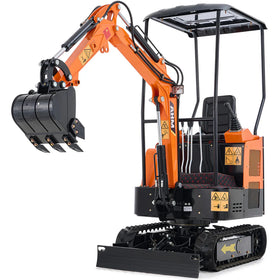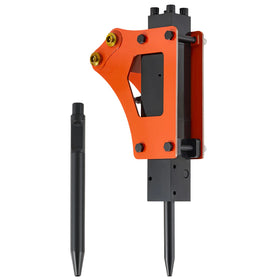If you are new to mini-excavator digging, you may be surprised by the variety of digging projects you can accomplish with your mini-excavator. The average 1-ton mini excavator, for example, can dig up to about 3-5 ft, which means utility trenches, backyard ponds, and many other small projects fall within its digging capacity.
However, digging with a mini excavator is a lot more than just dropping the bucket or digger and making a hole. There's a lot of technique involved, and understanding your machine's capabilities can mean the difference between a successful project and an expensive disaster.
This mini excavator digging guide will give you instructions on 5 projects you can dig with a mini excavator. Read, follow the instructions, and you will make the best of your excavator!
1. Dig a Trench
Trenching is probably the most common digging task for mini excavators. The compact size of a mini-excavator and the precision control that it allows make it perfect for trench digging. You can maintain consistent width and depth while working in tight spaces where larger equipment can't operate.

The AHM AX-12B 13.5HP, for example, is just 3'1" wide and 7'5" ft in height, but it packs a 69 in. max digging depth and 2585 lbf digging force. With sufficient mastery of a few mini-excavator trench-digging tips, you can easily use this machine to install utilities, drainage systems, or irrigation lines.
Digging a Trench With a Mini Excavator
To dig a trench with a mini excavator, you need a solid, reliable mini excavator and a trenching bucket. Follow these steps:
Step#1: Mark Your Route
Start by marking your route with spray paint or flags. You can call 811 to have utilities marked - hitting a gas line or electrical cable isn't worth the time you save skipping this step.
Step#2: Establish Your Trench Line
Begin with shallow passes to establish your trench line. Keep your bucket perpendicular to the ground and work in manageable sections rather than trying to dig the entire length at once.
Step#3: Dig Consistently
Maintain consistent width by using your bucket as a guide, and check depth frequently with a measuring stick.
Step#4: Keep the Hole Clear
Pile excavated soil at least two feet back from the trench edge to prevent cave-ins and make backfilling easier later. Take your time - good trenching is about precision, not speed.
For more details, refer to our complete guide on digging a trench with a mini-excavator.
2. Dig Footings
Digging footings for a house requires precision and consistent depth, which explains why mini excavators are ideal for residential foundation work. The controlled hydraulics of a mini excavator provide the accuracy needed for proper footing dimensions.
Digging Footings With a Mini Excavator
- Lay out your footings carefully using stakes and string lines. Double-check all measurements because concrete is expensive to fix if you get the dimensions wrong.
- Excavate in sections, maintaining straight walls and consistent depth. Most residential footings need to be 16-24 inches wide and extend below the frost line in your area.
- Use a laser level to ensure your bottom is level across the entire foundation. Clean any loose soil or debris from the bottom - your concrete needs to sit on undisturbed soil for maximum strength.
3. Dig a Pond
Digging a backyard pond is one of the most rewarding projects you can tackle with a mini excavator. The compact and maneuverable size of a mini excavator greatly facilitates controlled digging, which in turn makes it easy to create the varying depths and sloped sides that make ponds both functional and attractive.

How To Dig a Pond with a Mini-Excavator
Step#1: Decide on the Pool Depth
Plan different depth zones before you start digging. Most backyard ponds work best with maximum depths of 4-5 feet. Shallow areas work well for plants and wildlife, while deeper sections provide fish habitat.
Step#2: Dig From the Center
Start digging from the center and work your way out to create gradually sloping sides. This prevents edge collapse as you work deeper.
Create stepped shelves at different depths for aquatic plants and a natural appearance. Shape irregular, natural-looking edges rather than perfect geometric shapes - real ponds aren't symmetrical.
Step#3: Plan for Liner Installation
Finally, plan for liner installation by ensuring smooth sides without sharp rocks or roots that could puncture your pond liner.
Choosing a Mini-Excavator For Pool Digging
To dig a pool, you need a mini-excavator that is compact enough to fit into tight spaces and is compatible with several mini-excavator attachments to accommodate the various motions and movements that are required for pool digging.
At just 3'1" wide, the NW-A1 mini-excavator fits through standard gates and works in tight spaces where larger equipment can't operate. Its total digging force of 2585 lbf means it is capable of handling tough clay and compacted soil without any hiccups.
Moreover, it comes in a complete attachment package that includes a quick hitch, grading bucket, grapple, rake, hydraulic hammer, and auger. That is practically everything you need and more!
For more detailed instructions, refer to our comprehensive guide on how to dig a pond with a mini-excavator
4. Dig Up Tree Stumps
Removing tree stumps is where mini excavators really shine compared to other methods. The combination of digging force and hydraulic power makes quick work of even large roots.

How to Dig Up Stumps with a Mini Excavator
- To begin, cut the remaining stump as close to ground level as possible. Less stump above ground means easier removal and better leverage for your excavator.
- Dig a circle around the stump about 3-4 feet from the trunk to expose major root runs. Follow visible roots out from the stump and cut them with your bucket edge or a chainsaw.
- Use your excavator to rock the stump back and forth while lifting. The root ball will eventually break free from smaller roots you can't see. Fill the hole with soil and compact it to prevent settling.
What Kind of Mini-Excavator is Best for Digging Up Tree Stumps?
To dig up your tree stumps, you need a mini excavator with enough digging capacity to reach into the ground and get those tough tree roots. It also needs to be extra stable (to handle stubborn stumps), and easy to control and use.
With a 23 HP dual-cylinder engine delivering 70% more horsepower than 13.5 HP models, the AX-16S mini excavator is exactly the mini-excavator you need for stump removal. It has a maximum digging depth of 71 inches and a 3262 lbf digging force handle, demanding excavation work.
The retractable undercarriage adjusts from 37 to 47.2 inches, providing maximum stability for digging operations while fitting through narrow openings. Professional-grade hydraulic pilot controls ensure precise operation and immediate response.
Enhanced hydraulics come pre-filled and ready to use, with built-in monitoring for oil levels and temperature. The system easily handles high-flow attachments for specialized digging applications.
How Deep Can a Mini Excavator Dig?
Most mini excavators in the 1-2 ton range can dig between 5-8 feet deep, but the maximum digging capacity of a mini-excavator depends on its size.
A bigger 10+ ton mini excavator can dig up to 15 feet, whereas medium and small units can only dig as deep as 15 and 10 feet, respectively.
The NW-A1 from Ahm is a great example of small mini-excavators that pack surprising digging capability. At just 7.5 ft and 3.1 inches wide, it is equipped with a 13.5 HP Briggs & Stratton engine, giving you a max dig depth of 69 inches.
That's nearly 6 feet of digging capability, covering most residential projects.
| Excavator Size (Tons) | Dig Depth | Typical Uses |
| Small (1-5 Ton) | Up to 10 feet | General digging tasks |
| Medium (5-9 Ton) | 10-15 feet | Deeper trenches and foundations |
| Large (10+ Ton) | More than 15 feet | large foundations, and clearing land |
Theoretically speaking, the Maximum digging depth of a mini excavator is measured straight down from ground level. However, in real-world conditions, the effective digging depth might be altered by the type of terrain you are digging in.
If you have to work on a slope or dig around obstacles, your effective maximum digging depth might (understandably) be less.
Use Mini Excavator Attachments to Increase Digging Depth (And Effectiveness)
Also, with the right mini-excavator attachments, you can enhance the digging capacity of your mini-excavator.
- Heavy-duty buckets, for example, allow you to dig deeper through even tougher soils or larger volumes. This 200mm Trenching bucket digs up to 8" and is perfect for pipeline excavation, trench filling, and river dredging
- A hydraulic pump would increase digging efficiency by improving the grip of the mini-excavator and making it easier to handle irregular objects. Consider this

Conclusion
Understanding how to dig with a mini excavator comes down to matching proper technique to your specific requirements. Whether you're trenching utilities, digging foundation footings, creating backyard ponds, or removing tree stumps - Start shallow, work systematically, and put safety over speed.
Digging with mini excavator equipment is a skill that improves with practice. With quality machines like AHM's NW-A1 and AX-16S, you can tackle projects that previously called for expensive professional services on your own.
FAQ
What kind of projects can I do with a mini-excavator?
Mini-excavators are surprisingly versatile and can handle a variety of tasks including digging trenches for utilities, excavating footings for foundations, creating backyard ponds, and even removing tough tree stumps. These machines are great for small to medium digging projects around your home or job site.
How deep can a mini-excavator dig?
The digging depth depends on the size of the mini-excavator. Common small models can dig around 3 to 5 feet deep, while larger models or those with attachments can dig up to 10 feet or more. It’s important to consider terrain and obstacles, which may reduce effective depth.
What equipment or attachments do I need for different digging jobs?
For trenching, a trenching bucket helps maintain consistent width and depth. For ponds, shaping the edges and shelves is easier with a versatile bucket. Removing stumps may require a powerful excavator model with strong digging force and hydraulic control to break roots and lift stumps effectively.
How do I start digging a trench safely with a mini-excavator?
Begin by marking your route clearly and calling 811 to locate any underground utilities to avoid damaging gas or electric lines. Dig in small, manageable sections while keeping the bucket perpendicular to the ground, and pile soil away from trench edges to prevent cave-ins.
What are some tips for digging footings for a house?
Precision is key. Use stakes and string lines to mark your footing layout and ensure measurements are accurate. Excavate in sections and use a level to maintain a flat bottom. Remove loose soil so the concrete rests on firm, undisturbed ground.
Can a mini-excavator work well in tight spaces?
Yes! Mini-excavators are known for their compact size and maneuverability. For example, some models are only just over 3 feet wide and can pass through standard gates, making them perfect for residential projects or places larger equipment can’t reach.







